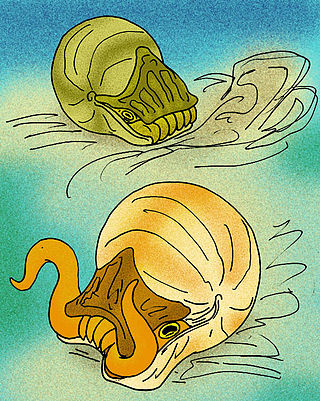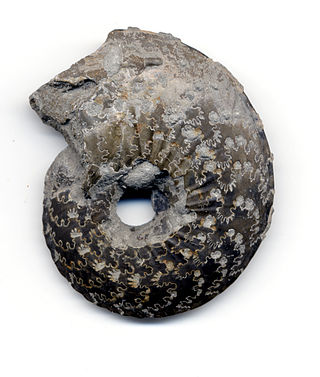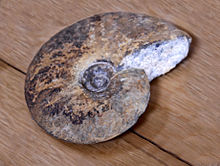Abbasites is an extinct genus of ammonites from the early Middle Jurassic epoch, included in the ammonitid family Erycitidae.

Acanthohoplites is an extinct genus of ammonites in the family Parahoplitidae that lived in the Aptian and Early Albian stages of the Early Cretaceous.
Alcidellus is an oxyconic haploceratacean ammonite from the Middle Jurassic.
Aspidostephanus is an extinct cephalopod genus belonging to the ammonite subclass, included in the perisphinctacean family Olcostephanidae that lived during the earliest Cretaceous and possible latest Jurassic. Fossils of the genus have been found in France, the Balearics, North Africa, and Argentina.

Arietites is a genus of massive, giant evolute, psiloceratacean ammonites in the family Arietitidae in which whorls are subquadrate and transversely ribbed and low keels in triplicate, separated by a pair of longitudinal grooves, run along the venter. Fossils are known world wide from the lower Sinemurian stage of the Lower Jurassic. Safari Ltd made an Arietites bucklandi figurine in 2014.

Arcestes is a genus of extinct ceratitid ammonites found in Triassic-aged marine strata.
Frogdenites is an extinct ammonite genus from the order Ammonitida that lived during the Middle Jurassic in what is now Europe, Canada, and Tibet. Frogdenites is included in the Otoitidae, a family which makes up part of the ammonitid superfamily, Stephanoceratoidea.
Ussuria is a genus of Lower Triassic ammonites with a smooth, involute discoidal shell with submonophyllic sutures, belonging to the ceratitid family Ussuriidae.

Oxynoticeras is an extinct genus of ammonite from the Early Jurassic of Europe and North America. This genus is characterized by its smooth shell, with almost invisible undulations on the flank, and a sharp keel.
Fissilobiceras ist ein glatter, komprimierter, involuter Ammonit aus dem unteren mittleren Jura (Aalenium/Bajocium) Europas, der 1919 von Buckman benannt wurde. Fissilobiceras gehört zur Familie der Hildoceratoiden (Hammatoceratidae).
Dorsetensia is a narrowly coiled discoidal ammonite from the early Middle Jurassic, lower Bajocian, belonging to the family Sonniniidae of the superfamily Hildoceratoidea. The inner whorls are ribbed or smooth, outer whorl is smooth. The outer rim (venter) is narrow, with a keel running along the middle. The umbilicus, the opening in the middle of the shell exposing inner whorls, is of moderate size with a sharp, sometimes undercut edge.

Oxynoticeratidae is a family of true ammonites included in the superfamily Psiloceratoidea.

Macrocephalites is a genus of the stephanoceratoid ammonite family Macrocephalitidae, diagnostic of the Callovian stage of the Middle Jurassic. Three subgenera, Dolikephalites, Kamptokephalites, and Pleurocephalites are recognized in addition to Macrocephalites itself, with Indocephalites tentatively included as the fourth.

Kepplerites is a moderately evolute ammonite from the lower Callovian included in the Stephanoceratoidea.
Megalytoceras is an extinct genus of ammonite from the middle Jurassic, belonging to the suborder Lytoceratina.

Cadoceras is an extinct ammonite genus belonging to the Cardioceratidae that lived during the Jurassic period from the late Bajocian to the early Callovian.

Meekoceras is an extinct genus of ceratitid ammonites with a discoidal shell that lived during the Early Triassic Epoch.
Ochetoceras is a genus of ammonites, belonging to the Oppeliidae, that lived during the Late Jurassic from the early Oxfordian to the early Tithonian, and type for the subfamily Ochetoceratinae.
Oxydiscites is a genus of ammonites from the Upper Jurassic Kimmeridgian included in the Ochetoceratinae, Oppeliidae. The shell is involute, compressed, with a minute umbilicus, sharp venter with a tall finely toothed keel, and faloid ribbing.

Hammatoceras is a genus of ammonites belonging to the family Hammatoceratidae which lived during the Toarcian stage of the Early/Lower Jurassic between about 184 and 175 million year ago.










